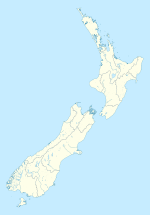Turakirae Head

Turakirae Head is a promontory on the southern coast of New Zealand's North Island.[1] It is located at the western end of Palliser Bay, 20 kilometres southeast of Wellington, at the southern end of the Remutaka Range. The headland hosts a series of uplifted Holocene marine terraces and beach ridges that record uplift from past earthquakes.[2] After each earthquake, a new terrace and beach ridge formed below the previous one at sea level. The most recent earthquake to uplift Turakirae Head was the 1855 Wairarapa earthquake, which raised the shoreline up to 6.4 m.[2] Turakirae Head is also home to a seal colony and southern bull kelp.[3]
Turakirae also marks the southernmost coastal boundary point for the Ngāti Kahungunu tribe which extends as far north as Paritu which is just south of Gisborne.
Scientific reserve[edit]
During the 1960s, thousands of tonnes of boulders were removed from Turakirae Head to be used in construction of the Wellington Urban Motorway.[4] In 1970 the government bought 240 acres of land at Turakirae Head from the Riddiford Estate, in order to protect and preserve the geologic record shown by the raised beaches along the shoreline which was in danger of being destroyed by further possible removal of rock for public works.[5] Access is via the Coast Road from Wainuiomata, which ends 3 km from the reserve, and then by foot across private land.[6] A fur seal colony became established at Turakirae Head in 1950, and up to 500 seals, mostly juvenile males, overwinter at the colony each year.[6] The reserve is also home to skinks and geckos, and birds such as the banded dotterel, Caspian tern and variable oystercatcher. Fire and grazing by sheep, cattle and rabbits have affected vegetation in the area. In 1998, a new population of shrubby tororaro – classified as a nationally threatened plant – was established at Turakirae Head to bolster an existing population of the shrub at the reserve.[6]
Ship scuttling area[edit]
Between 1905 and 1952, 29 ships were scuttled in the waters off Turakirae Head. The scuttling ground was an area approximately five kilometres south-east of the headland, where the water is about 700 metres deep. Although the ships were usually stripped of their fittings before disposal, the deep water is likely to have preserved the hulls. The site is archaeologically significant because the vessels sunk there include a range of ships dating from the 1830s to the early twentieth century, built of wood or iron and powered by sail or steam and thus representing changes in technology.[7] After 1952, ships were scuttled in deeper water further out in Cook Strait, south-west of Cape Palliser.[7]
References[edit]
- ^ "Place name detail: Turakirae Head". New Zealand Gazetteer. New Zealand Geographic Board. Retrieved 25 March 2010.
- ^ a b McSaveney, Maurice J.; Graham, Ian J.; Begg, John G.; Beu, Alan G.; Hull, Alan G.; Kim, Kyeong; Zondervan, Albert (September 2006). "Late Holocene uplift of beach ridges at Turakirae Head, south Wellington coast, New Zealand". New Zealand Journal of Geology and Geophysics. 49 (3): 337–358. doi:10.1080/00288306.2006.9515172. ISSN 0028-8306.
- ^ Vaux, Felix; Parvizi, Elahe; Craw, Dave; Fraser, Ceridwen I.; Waters, Jonathan M. (2022). "Parallel recolonisations generate distinct genomic sectors in kelp following high magnitude earthquake disturbance?". Molecular Ecology. 31 (18): 4818–4831. doi:10.1111/mec.16535. PMC 9540901. PMID 35582778.
- ^ "Threat To Wellington seal colony". The Press. 30 June 1965 – via Papers Past.
- ^ "Land at Turakirae Head Bought To Preserve Earthquake Record". Forest and Bird (176): 3. 1 May 1970 – via Papers Past.
- ^ a b c "Turakirae Head Scientific Reserve". www.doc.govt.nz. Retrieved 16 July 2024.
- ^ a b Dodd, Andy (30 June 2013). Coastal & underwater archaeological sites of the Wellington region [report] (PDF). Paekakariki, New Zealand: Subsurface Limited. pp. 244–255.
41°26′02″S 174°55′05″E / 41.4339°S 174.9181°E

